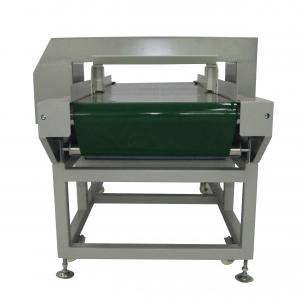

Add to Cart
Sewing needle metal detector for fabric garment shoes apparel textile industry
Technical details:
| Name | Needle detector |
| Model | VFGH-800 |
| Detection tunnel size | Width: 600mm height: 150mm |
| Tunnel type | Horizontal |
| Detection ability | Ferrous, magnetic metals and broken needles |
| Speed of conveyor belt | 20m/min ( Other speed optional, adjustable speed optional) |
| Metal detector total length | 1650mm (Other optional) |
| Operation language | English (Other languages optional) |
| Conveyor belt | Green color PVC |
| Height from floor to conveyor belt | 700+-50 mm (Other optional) |
| Rejection system | Buzzer alarms and belt stops / Buzzer alarms and return back |
| Power Supply | 220V 50Hz(Other optional) |
| Frame material | Carbon steel |
| Ingress rating | IP54 |
| HS code | 9031809090 |
Applied industries:
Garments, Fabrics, Apparels, Textiles, Cloths, Shoes, Suits,
Trousers, Socks,etc.
Product function:
Identifying whether there are any undesirable metallic substances
and broken needles left-over or embedded in the garment and
accessories in manufacturing and sewing process.
Features:
1. 32 bit digital computer chipes with latest workmanship and
technology
2.Auto shutdown energy saving mode after no detection for more than
10 minutes
3. 8 points positioning technology enabling to find out specific
location of borken needles
4. Counting function for a better production management
5. Excellent anti-interference design with good detection stability
6. Printing function for production management
Principle
The magnetic lines of force travel from the North pole to the South
pole. When there is any magnetized substance passing through it,
the magnetic field will get changed, which can trigger off the
needle detector, causing it to sound the alarm.
Now let us move on to the factors that can cause the garments to fail the needle detection.
1.Manufacturing/Special Processes
The manufacturing of garments often involves various technologies
and processes to convert the raw materials into the finished items
that are wearable. Garments may not pass the needle detection due
to the special treatment applied or post-treatment which has not
been disposed of properly.
The needle detector will respond to:
2.Needle Detectors
Most of the detectors are sensitive enough to ensure the detection
accuracy. However, different types of detectors, inconsistent
sensitivity of the detection unit as well as different positions or
directions in which the needle passes through a detector will lead
to a different sensitivity level and result in the differences in
detection.
If the garments being checked are placed in the part that features extremely strong or weak sensitivity, or when the garments being inspected are not placed within the detecting area where they are supposed to be, the testing result will be inaccurate.
Additionally, when magnetic substances, stain or dust adhere to the conveyor belt, the detector will malfunction, resulting in false alarm and the inaccuracy in testing.
